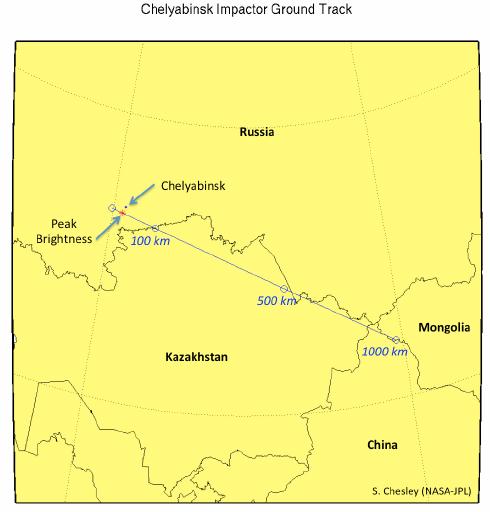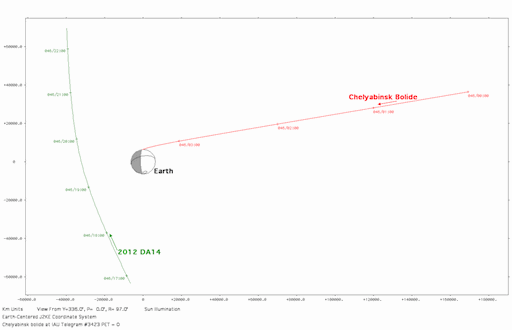The large fireball (technically, a “superbolide”) observed on the morning of February 15, 2013 in the skies near Chelyabinsk, Russia, was caused by a relatively small asteroid approximately 17 to 20 meters in size, entering the Earth’s atmosphere at high speed and a shallow angle. In doing so it released a tremendous amount of energy, fragmented at high altitude, and produced a shower of pieces of various sizes that fell to the ground as meteorites. The fireball was observed not only by video cameras and low frequency infrasound detectors, but also by U.S. Government sensors. As a result, the details of the impact have become clearer. There is no connection between the Russian fireball event and the close approach of asteroid 2012 DA14, which occurred just over 16 hours later.
U.S. Government sensor data on fireballs are now reported on our website.
The February 15th event is the first entry on this new site, and it provides the following information about the fireball:
Note that the total energy of a fireball event is several times larger than the observed total radiated energy. The JPL fireballs website uses the following empirical formula derived by Peter Brown and colleagues to convert the optical radiant energy Eo into an estimate of the total impact energy E (see: Brown et al., The flux of small near-Earth objects colliding with the Earth. Nature, vol. 420, 21 Nov. 2002, pp. 294-296).
E = 8.2508 × Eo0.885
During the atmospheric entry phase, an impacting object is both slowed and heated by atmospheric friction. In front of it, a bow shock develops where atmospheric gases are compressed and heated. Some of this energy is radiated to the object causing it to ablate, and in most cases, to break apart. Fragmentation increases the amount of atmosphere intercepted and so enhances ablation and atmospheric braking. The object catastrophically disrupts when the force from the unequal pressures on the front and back sides exceeds its tensile strength.
This was an extraordinarily large fireball, the most energetic impact event recognized since the 1908 Tunguska blast in Russian Siberia.
The meteorites recovered from the Chelyabinsk fireball are reported to be ordinary chondrites, which have a typical density of about 3.6 g/cm3. Given the total energy of about 440 kt, the approximate effective diameter of the asteroid would be about 18 meters, and its mass would be roughly 11,000 tons. Note that these estimates of total energy, diameter and mass are very approximate.
An approximate path for the Chelyabinsk impactor can be calculated from the newly released fireball data. (A similar calculation can be made from analysis of video records of the event; both methods yield similar results.) The first diagram shows the ground track of the impactor over the last minute or so before impact. The altitudes along this ground track have been called out and the asterisk on the path indicates the point of peak brightness, just south of Chelyabinsk.

The second diagram shows the impactor’s final trajectory over the last several hours, as it approached the Earth along a direction that remained within 15 degrees of the direction of the Sun. Asteroid detection telescopes cannot scan regions of the sky this close to the Sun.
The third diagram shows the orbit of the impactor about the Sun. The orbit reaches from the asteroid belt at its farthest from the Sun to near the orbit of Venus at its closest to the Sun. The impactor had likely been following this orbit for many thousands of years, crossing the Earth’s orbit every time on its outbound leg.
Asteroid 2012 DA14 made a very close flyby of the Earth just over 16 hours after the Russian fireball event, passing within 27,700 km (17,200 miles) of the Earth’s surface, but there is no connection whatever between these two events. First of all, the two objects approached the Earth from completely different directions, and had entirely different orbits about the Sun. A custom version of the JPL orbit display applet has been created to show the orbits of the Chelyabinsk impactor and 2012 DA14 at the same time:
A second reason we know the two asteroids approaching Earth on Feb. 15 were unrelated is their disparate compositions. Telescopic spectral data do not support any physical connection between asteroid 2012 DA14 and Chelyabinsk meteorites. Nicholas Moskovitz and Richard Binzel (MIT) report 2012 DA14 displays spectral colors which suggest a carbon dominated composition similar to CO or CV carbonaceous chondrite meteorites with abundant calcium- and aluminum-rich inclusions. On the other hand, meteorite fragments being recovered from the fireball event are reported as silicate-rich ordinary chondrites; a completely different and unrelated class of meteorites. About 80% of all meteorite falls are in the ordinary chondrite category.

Peter Brown, University of Western Ontario and William Cooke at the Marshall Space Flight Center provided impactor details. Paul Chodas and Steve Chesley (JPL) provided orbital computations and diagrams. Ron Baalke (JPL) provided the custom interactive applet showing the heliocentric orbits of both 2012 DA14 and the asteroid impacting the atmosphere over Russia. Richard Binzel (MIT) provided information on the nature of the atmospheric impactor and near-Earth asteroid 2012 DA14. Dan Adamo provided Diagram 4.